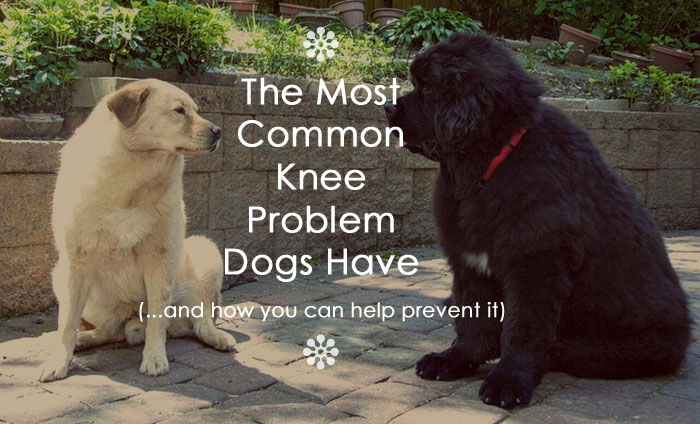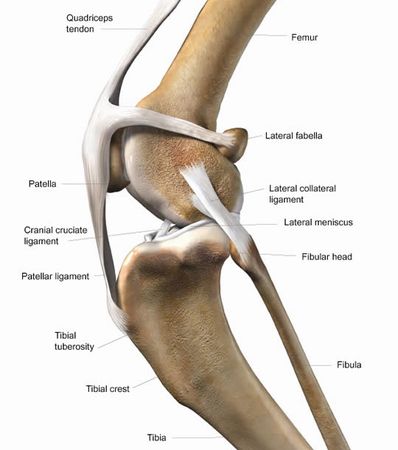
(…and how you can help prevent it)
Cranial cruciate ligament (CCL) disease is a condition which is sadly over represented in today’s veterinary clinics. It is a weakening of the ligaments, or bands of tissue, which stabilize a dog’s knees, connecting the femur (bone above knee) to the tibia (bone below knee). Why is this such a common condition, especially in larger breeds, and what can we do to prevent it from happening in the first place?
“Rupture of the cranial cruciate ligament is one of the most common reasons for hind limb lameness, pain, and subsequent knee arthritis.”
American College of Veterinary Surgeons (ACVS)
Causes
Traumatic injury may result in the tearing of the CCL. This is more common in large and/or overweight dogs such as Newfoundlands, Mastiffs, St. Bernards, etc. The joint is simply overworked and gives out. A ruptured CCL will result in the dog not being able to put much, if any, weight on its leg.

However, an important point to note, also from the ACVS:
“Ligament rupture is a result of subtle, slow degeneration that has been taking place over a few months or even years rather than the result of acute (sudden) trauma to an otherwise healthy ligament (which is very rare).”
Healthy joints are the best protection from this debilitating condition, including trauma related injuries.
There is much information available which discusses (very expensive) surgical and non-surgical treatment of CCL ruptures and tears, but let’s have a look at nutrition and prevention.
What is missing from a dog’s diet that would cause CCL disease and injury?
Nutrient Deficiency
Healthy ligaments in dogs don’t just tear for no reason. Veterinarians often see dogs in their clinics that have ligament ruptures or tears, yet have not experienced some form of trauma, such as getting hit by a car or falling from a height, etc.
“Fat or out of shape dogs tax their ligaments more than thin dogs, but my patients weren’t fat or out of shape. They were active, healthy animals. They weren’t over-vaccinated, and they weren’t de-sexed. That left nutrition as a possible cause for the vast majority of CCL injuries I was seeing in practice.” (Read more here)
Karen Shaw Becker, DVM
In research that Dr. Becker has done, in the context of her years of veterinary practice, she has discovered that a crucial element has been missing from the diet of patients with CCL disease…a lack of manganese. Dogs require a high level of manganese, yet processed pet food and less than carefully prepared diets (including raw) do not contain enough manganese to support a dog’s joints.
“So where does manganese come from in the ancestral diet? Minute amounts come from meat, liver and bone, but not nearly enough to meet a dog’s daily requirements (and hence why so many dogs become manganese deficient). The richest source of manganese comes from the animal pieces and parts none of us feed, primarily hair, feathers and wool.”
Karen Shaw Becker, DVM
Prevention
An ancestral diet (whole prey animal) might average 3.1 mg of manganese per 1000 kcal (calories). This is very supportive of ligaments and joints. Since most people, even those that feed their dog raw meat and organs, are not in the habit including prey animal hair, feathers or wool to their dog’s food, proper levels of manganese must come from other sources. Those that feed only kibble to their dogs are providing an even lower amount of manganese, well below what is necessary to support joint health.
Joint health can prevent CCL ruptures and tears (except of course in the case of highly traumatic injury). Nutrition is required for joint health, in tandem with proper exercise and fitness. Manganese is a key nutritional element required for joint health.
BioVITES and BioJOINT are products which provide in abundance the manganese and other nutritional elements that your dog needs to have healthy joints throughout its lifespan. If you want to help your dog prevent this unfortunate and unnecessarily common condition or you want to help your dog to recover and strengthen post-surgery, please contact us for more information about how these supplements can serve your dog’s joint and overall health.
